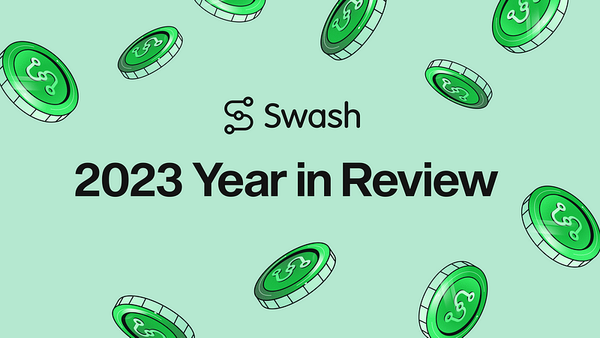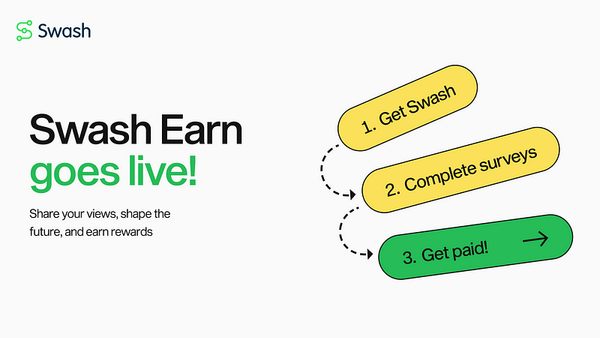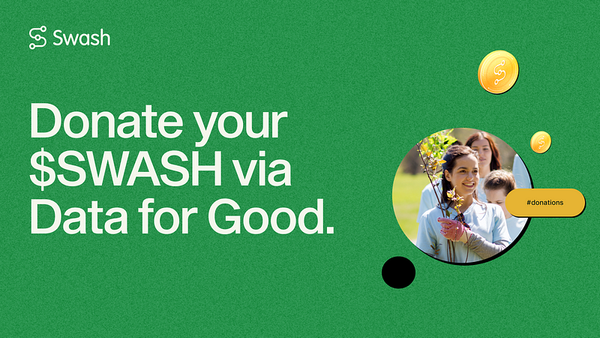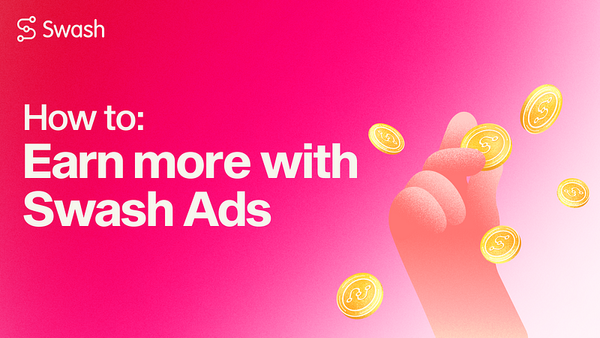AMA Recap: Swash meets Satoshi Club
Swash is committed to the broader education of the crypto space while spreading the message about the new data economy, built upon the…
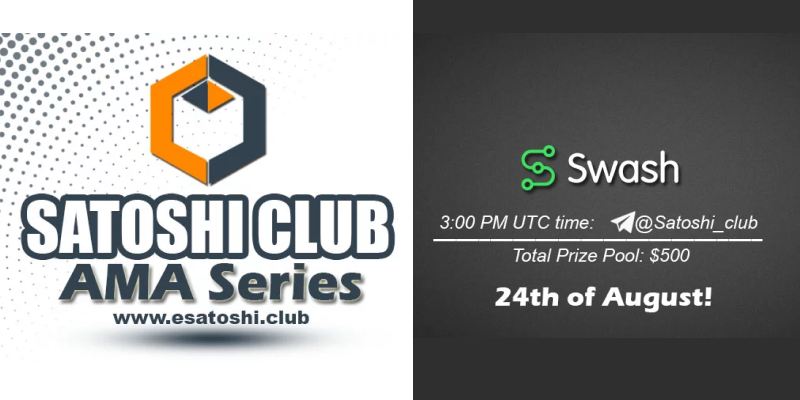
Swash is committed to the broader education of the crypto space while spreading the message about the new data economy, built upon the principles of decentralisation and individual sovereignty.
We were thrilled to participate in an AMA with Satoshi Club, a leading educational platform for blockchain, and to shed light on how Swash is propelling the new infrastructure of decentralised data ownership and giving back control to individuals.
On August 24th, Swash’s Chloe Diamond, went on the Satoshi Club Telegram to answer all questions about Swash’s solutions and roadmap while delving into the principles of the new data economy, crypto, and Web 3.
Keep reading for all the amazing questions asked by the Satoshi Club community and Chloe’s insights.
Selected questions from the community
Swash’s slogan is “Your data, your income.” I wonder how Swash is going to make money from the platform? What are the other ways that Swash makes money?
Chloë:
Swash receives 30% of profits made from data sales, the rest is distributed to members. Each solution provides added value streams and some, such as sApps (applications built on Swash) offer new opt-in methods for people to make even more from their contributions. An advertising solution, called sAd, will use Swash data to create a fair, transparent, and efficient advertising platform. That’s just one of many, but I feel it relates closest to your question. More details on that can be found in the whitepaper.
Who receives the data you sell? Who are your partnerships right now?
Chloë:
When we sell the data, the types of businesses who will purchase it include market and analytics companies, AI/ML startups, hedge funds, advertisers and brands, and researchers, to name a few.
Our partnerships include Chainlink, Streamr, Ocean Protocol, Outlier Ventures, Boson Protocol, Amasa, 1 World Online, Tapmydata, Crunch Digital Media, and the DPPA. The world of decentralised data is an incredible, collaborative space to be!
I was curious about your token cross-chain support. It says on your whitepaper that Swash’s token would be built for both BEP-20 and ERC-677. It is rare to see tokens that have ERC-677 support because others mostly use the standard ERC-20. Why did Swash opt to deploy its Ethereum network support under the ERC-677 interface? What could be its advantages against the commonly used ERC-20?
Chloë:
SWASH will originally be minted on Ethereum then bridged to other networks like BSC, xDai, and Polygon.
The reason we chose ERC677 instead of the ERC20 is because the ERC20 standard isn't well designed for cases where a contract wants to execute actions after receiving an ERC20 token. For the ERC-20 tokens, they should first allow the contracts to transfer their tokens, then the contract can transfer tokens from their wallet using the transferFrom function of the ERC20 contract. This basically means that two transactions should be executed (e.g. when swapping tokens in Uniswap).
ERC-677 is a solution for this, providing a transferAndCall function which allows users to send tokens to contracts and for the receiving contract to receive the tokens all in one transaction.
ERC677 has all the benefits of ERC20 while addressing its limitations. It is more advanced and allows for more functionality which is why it's used by the likes of Chainlink also. It’s fully compatible with all the ERC20 and mainnet infrastructure and tools while offering a better UX experience and lower costs!
What are the main use cases of $SWASH and which benefits does it provide for long term holders?
Chloë:
The main use cases for $SWASH are:
- Incentivise: As an incentive system, ecosystem actors will be rewarded with Swash tokens in return for their participation.
- Transact: All data transactions across all marketplaces, platforms, and applications will be distributed in SWASH. This includes value generated within the business intelligence and analytics platform (sIntelligence), the data computation environment (sCompute), and solutions developed utilising Swash technology (sApps).
- Govern: Swash token holders can vote for projects they wish to see receive funding from the Swash DAO fund, decide on new roadmap developments or modifications, and to take part in token-related decisions.
- Multiply: People can individually and collectively contribute the value of their data to social development causes and use it for value exchange both within and outside the Swash universe, such as redeeming earnings for products or staking liquidity.
For long term holders, the value of Swash will increase with adoption and growth of the ecosystem. As more people join, not only does the value of data become more valuable but adoption of the $SWASH token will increase also, so there’s plenty of incentive to get in early.
Plus, as demand for $SWASH will increase alongside network adoption, generated value may be used to balance the token supply, likely through periodical token ‘burning.’
Can you explain how your governance model will strike a balance between a non-democratic central governance and a democratic community oriented DAO? How are proposals made and how will you achieve optimum governance by incentivising stakeholders in a bid to ensure an accelerated decision making process? How will the SWASH allocated for DAO growth be shared or distributed?
Chloë:
Decisions relating to the technology roadmap are made by the team, so that’s the centralised part, but decisions related to network parameters (like the network fee) and decisions around funding projects that integrate their solution with Swash will be made by the DAO. The distribution mechanism of the DAO pool will be announced during the project development.
Please share with us the roadmap to know what else is coming for Swash.
Chloë:
We have:
- Rise (Q3 2020 — Q1 2021) — Swash application growth
- Surf (Q3 2021- Q4 2021) — sIntelligence platform development
- Flow (Q4 2021 — Q3 2022) — sCompute and sChannel launch
- Surge (Q2 2022 — Q4 2022) — First sApp releases
- Onshore (Q1 2023 — Q3 2023) — sApp development and upgrades
- Swash (Q4 2023 — Q2 2024) — Swash smart contracts
Is the Swash App available through a mobile application? If not, do you have plans to launch your own mobile application? When can we expect the Swash app to be available on both IOS and Android for easy access? What will be its innovative features while it is being upgraded with the mobile version?
Chloë:
Swash is currently available on Android for Kiwi and Yandex, although a mobile version of Swash for all browsers is in the works. It’s a priority for us to expand Swash to mobile to cater to wider audiences and it will be one of the developments alongside our First Wave Solutions — all of which seek to bridge the gap and provide even more value to the community.
Is there any kind of KYC needed to join your platforms? Have you done any audit process? Can users be sure that their info will not be stolen
Chloë:
No, there’s a very short onboarding process (it takes just a few minutes). The setup process creates a wallet for you and asks for some basic demographic details (nothing that can be used to personally identify you) to create a less fragmented dataset. Yes, audited by Certik.
Unfortunately, peoples’ data is being stolen in the existing model which is exactly why Swash was born! People can be certain that their data won’t be stolen — we have measures in place to ensure that the data is stored properly, and it’s anonymised and end-to-end encrypted for added security.
There is no argument that when it gets to a certain stage of browser usage, it slows down effectively because it uses too much CPU and RAM. Adding a plugin on such a browser now will add more to its problem. Can you briefly tell us about the technology used to build Swash plugin, how heavy is it going to be in a browser? And, going through your whitepaper, I could identify up to 15 Swash elements with less details about them. Can you enlighten us on how each of them works in this project?
Chloë:
Good point! This is something we’ve been conscious of since day 1. We’ve released at least 15 versions of the extension over the last two years and have more than 60000 people who have installed it and, so far, there hasn’t been any major report on CPU or RAM usage. The extension is developed using Chrome and Firefox SDKs and is mostly based on Javascript, Typescript, and React.
Even though our whitepaper is pretty huge, we actually reduced a lot of technical descriptions relating to the architecture to simplify it and make it easier to read. If you have specific questions, feel free to message the team in the Swash official channel.
Could you tell us how to buy $SWASH?
Chloë:
Details of the public sale will be announced shortly. For private investment inquiries you can connect to us through the Swash Telegram. Don’t forget to subscribe to our newsletter for those updates too!
Environmental causes, children’s charities and COVID support are just a few of the many social good organizations you can contribute to through Swash. This is truly amazing and noble. My question is, why have you decided to earmark part of your profits for redistribution in this way? What are the charities that the Swash team is currently focusing on? What percentage of profits has been earmarked for this noble purpose and what impact will this noble cause have on the development of your project?
Chloë:
There are several reasons why we will be bringing a donation feature to Swash:
- Following the Ecosia model (they have 16 million users!), people are motivated by being able to do good without needing to change their habits;
- Attracting larger, more diverse audiences through social goods orgs and promotion to their own communities will increase the value of Swash data (more data + more diversity = more value for everyone);
- At least to start with, the amount people can earn through Swash might not be very much to make a big difference to their lives. But to know that they can automatically donate it and make a difference to someone else is huge;
- If Swash can make it easier for people to make a positive difference, then why not make it possible?
The charities we are focusing on are those who already accept cryptocurrencies as donations. If you know of any, please share and we can consider adding them too. The percentage of profits donated is up to the individual.
In terms of the impact this will have on Swash, it’s important to remember that data is unique in the sense that the more of it there is, the more valuable it becomes. Connecting to new audiences not only grows the number of people in the Swash community, but it also means bringing in more diverse audiences.
Swash is designed in a way where people don’t necessarily need to understand crypto, blockchain, or the world of data to be able to start earning, so even less tech-savvy people can get involved and, if they like, automatically donate to their chosen social goods org. Increased size and improved diversity within Swash data makes it more valuable, returning even more value back to Swash members!
Open questions from the community
What are Swash plans to create an awareness in the community about the importance of personal data? How will you educate people?
Chloë:
I love this question — it’s so urgent! Of course, alongside the materials we share about the data economy in general, Swash actually allows people to put their data rights into practice. By showing people exactly what data is captured and then giving them the option to choose whether to share that particular data point or not allows them to practice having control and ownership over their data while learning what data is actually considered valuable
It caught my attention that Swash claims that: “Swash operates on a better-than-free model”. But if I’m honest with you, this is the first time I see such a thing, so, can you tell us more about this and what does it mean to have a “better-than-free model?” What advantages does this model provide to your platform and how is it a better option for it than any other available model? Most importantly, what kind of benefits does this “Better-than-free model” allow you to provide to your users as an all-inclusive data ecosystem that puts people first?
Chloë:
Happy to! Many of us know how web 2 operates with free services (such as Facebook or Google). Unfortunately, those services are free because they rely on extractive systems that don’t bring any value back to the users on the platform. Better-than-free means that, not only is Swash’s service free to individuals, it actually pays them!
How important is the community to you? How can we collaborate or help you for the development of the project ?
Chloë:
Swash is a community-first project. Its entire ethos and model is built on the power of redistributing value back to everyone involved. Swash works because all ecosystem stakeholders — people, businesses, and developers, are incentivised to participate.
The best way to support is to spread the word! The bigger the community, the more value everyone gets in return
How can I do my research about your project? Do you have any whitepaper released and can you provide me with all the social media links and blogs?
Chloë:
After adding the Swash browser extension, how can I get paid for my data? Do I have to stake any tokens for this?
Chloë:
Once installed, you don’t have to do anything! You just leave it on and it works for you in the background. You can stake tokens to earn more though.
The first wave solutions to be built on top of Swash core technology include Data Union, sIntelligence, sApps, and sCompute. Can you introduce these 4 core technologies?
Chloë:
Happy to.
- Data Union: Optimising individual agency as a collective force by rewarding union members for the value of their data;
- sIntelligence: Bringing unique insights to businesses across all industries through a customisable, comprehensive web-based platform;
- sApps: Expanding the Swash ecosystem with the tools, community, and culture for building the next era of data solutions;
- sCompute: Uniting innovation with access by making on-site data computation capabilities a reality.
Check out this blog or whitepaper for extra details!
What kind of partnerships do you have with Chainlink and Ocean protocol?
Chloë:
With Chainlink, we’re working with them to make proportional revenue distributions a reality. With Ocean Protocol, we were their Day 1 Ocean Market Data Launch Partners, we received a grant from Ocean Shipyard, and Bruce Pon (Founder) is one of our advisors.
Swash, the world’s first and most successful Data Union, is expanding into an all-inclusive data ecosystem. What is a Data Union?
Chloë:
A Data Union is an organised structure that works to manage and protect the interests of its members. As a result, those members have greater power and control over how their data is collected, accessed, and used while receiving a portion of the profits generated.
By rewarding people for the value of their data, people can earn for activities they already do online — like surfing the web — enabling individuals to practice their data rights while celebrating their role as essential value providers in a thriving network.
If we use Swash, data we already give away for free is captured while we surf. As I read, Swash pools our data together with other Swash members to create a Data Union. When data buyers purchase the data from that Data Union, its members receive their share of the profits generated. How is the data value calculated? Is our sensitive data exposed? How are profits divided? What percentage of the profits does the owner of the data receive?
Chloë:
The price of data is difficult to answer, as the industry is notoriously shady. As Swash grows, we hope to shine light on that. Regarding what people can expect to earn, there has been research on it: Some estimate $5–10 per month, others estimate $200, some say $2000, and another says up to $24K per year! The data industry is vast and the EU Commission pegs it at around $3 trillion dollars.
Profits are currently divided equally but we’re working on proportional distribution. No, your sensitive data isn’t captured in the first place.
How does swash work? Can you share with us how can we profit from it?
Chloë:
Simply put, Swash captures, pools, and sells your data on your behalf. When the data is purchased, those profits are automatically redistributed back out to the people who contributed their data.
Here’s how it affects each ecosystem stakeholder:
For people:
- Regain ownership and receive passive income as they surf the web;
- Collectively invest value of data into social development;
- Exchange data value for alternative ecosystem benefits.
For businesses:
- Access high-quality, zero-party data at scale;
- Save time and money by eliminating intermediaries and reducing ad fraud and bots;
- Improve the reputation and sustainability of business practices.
For developers:
- Accelerate innovation due to improved access to diverse data;
- Be part of a new generation of data solutions;
- User acquisition through incentivisation mechanics and communication.
About Swash:
Swash is an ecosystem of tools and services that enable people, businesses, and developers to unlock the latent value of data by pooling, securely sharing, and monetising its value.
People share their data to earn while retaining their privacy. Businesses access high-quality, zero-party data in a sustainable and compliant way. Developers set up and build systems within a collaborative development framework with ease.
Swash is reimagining data ownership by enabling all actors of the data economy to earn, access, build and collaborate in a liquid digital ecosystem for data.
Let’s connect: Twitter | Telegram | Reddit | LinkedIn | Website | Newsletter
Originally published at https://swashapp.io on August 27, 2021.


